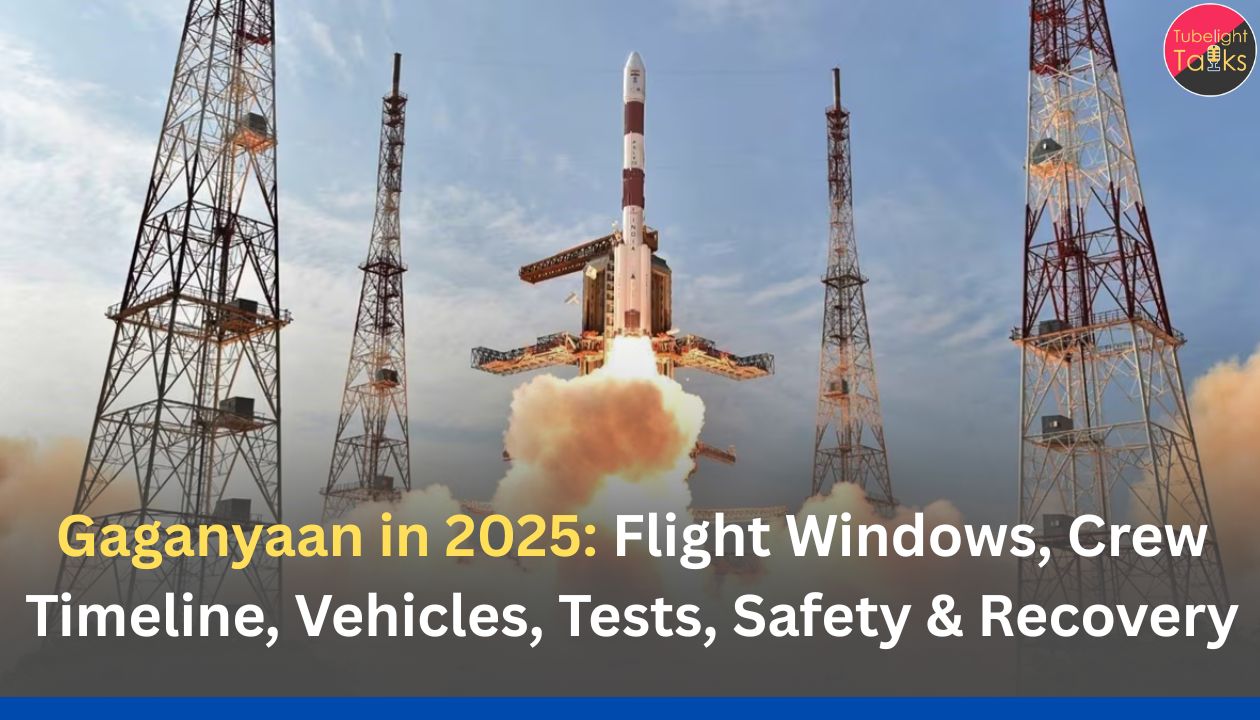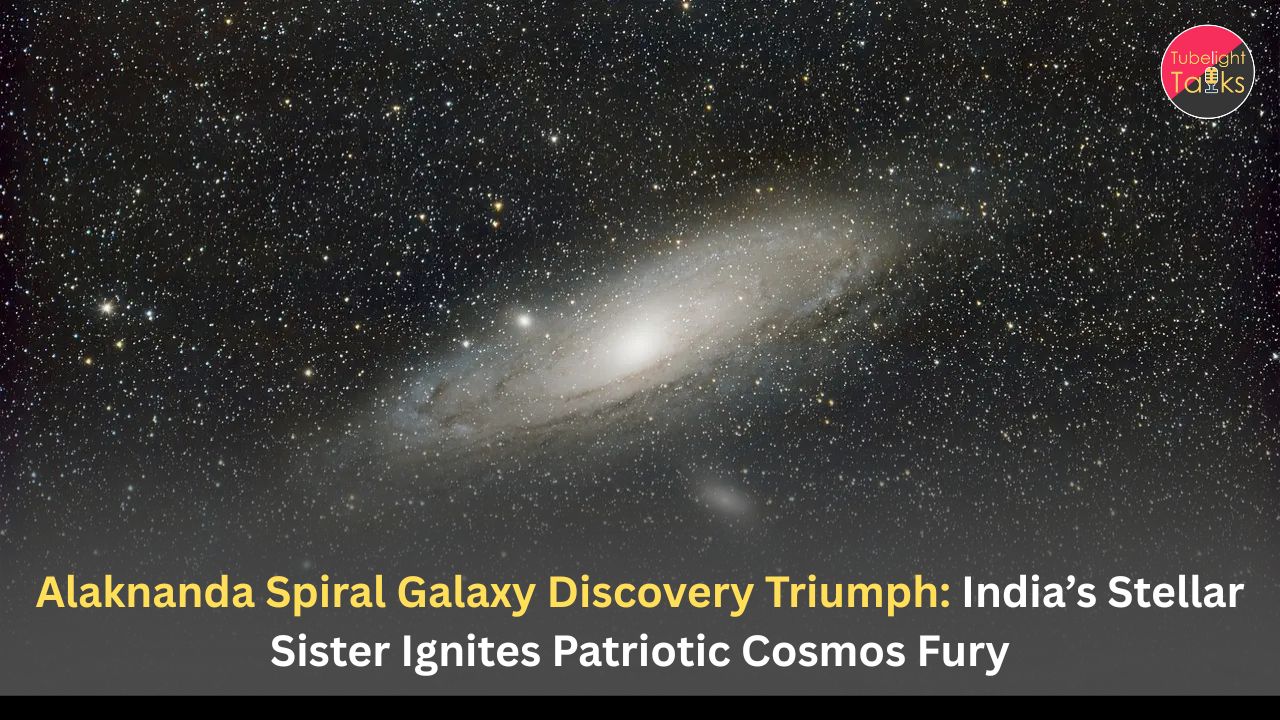Gaganyaan in 2025: India’s Gaganyaan programme has moved from concept to final-phase execution in 2025. The government’s latest brief sets a crew mission target of the first quarter of 2027, preceded by an uncrewed orbital mission whose window opens in late 2025, with Vyommitra aboard as a test payload. Along the way, ISRO has ticked off critical milestones: the TV-D1 in-flight abort demo, service-module propulsion qualification, and international recovery cooperation.
This explainer stitches together the official schedule, vehicles, safety stack, and what to watch—so your newsroom or classroom can speak precisely about what’s confirmed and what’s next using only ISRO/PIB/AIR sources.
Where the Timeline Stands (and how to cite it)
- Crewed launch target: The government states the first human spaceflight under Gaganyaan is targeted for Q1-2027, marking the programme’s final phase. Quote the PIB release (date-stamped) when referencing the crew date.
- Uncrewed orbital mission window (G1): Parliamentary replies and factsheets pegged the first uncrewed orbital flight in Q4-2025; AIR reported in late October that ISRO planned the uncrewed flight in December with Vyommitra. Treat this as a window until an exact launch press note drops.
- Test vehicle & subsystem cadence: After TV-D1 (Oct 2023) validated the Crew Escape System in-flight, ISRO has progressed service-module propulsion and further test vehicle missions per official trackers.
Copy-ready line: “Gaganyaan has entered its final phase; the first human spaceflight is targeted for Q1-2027.”
The Stack: Vehicles, Modules, and What Each Piece Does
Human-Rated Launch Vehicle (HLVM3)
HLVM3 (human-rated LVM3) is the heavy-lift rocket adapted for crew safety: redundancy, vibration/acoustic qualification, human-rating margins, and mission abort compatibility. ISRO’s programme pages and timelines anchor the nomenclature and purpose.
Crew Module (CM) & Service Module (SM)
- Crew Module (CM): A pressurised habitat for a 3-member crew to orbit ~400 km for ~3 days, with life support, avionics, and parachute-based recovery for splashdown in Indian waters.
- Service Module (SM): Provides power, propulsion, thermal control. In July 2025, ISRO announced the successful development/qualification of the SM propulsion system technology for Gaganyaan missions—a key gating item.
Crew Escape System (CES) & Test Vehicle
- TV-D1 demonstrated an in-flight abort at ~Mach 1.2, with clean CM separation and recovery—exactly the regime most challenging for abort dynamics. Further test-vehicle flights expand envelope confidence.
Vyommitra on the Uncrewed Flight
ISRO has repeatedly indicated that an articulated humanoid “Vyommitra” will ride the uncrewed mission to exercise crew interfaces and cabin environments; AIR noted this in its October broadcast.
Safety, Redundancy, and Human-Rating—What It Actually Means
- Human-rating standards push conservative design, fault-tolerant avionics, rigorous qualification (vibe/acoustic/shock), and abort-anytime logic layered into flight software. ISRO’s updates tie specific subsystem milestones (e.g., SM propulsion) to this envelope.
- Abort system life-cycle: Testing spans pad-abort, ascent-abort (transonic to max-q to upper-stage segments), parachute system drop-tests, and sea recovery rehearsals. TV-D1 validated the most public element; others continue under ISRO’s test campaign.
Recovery: How the Crew Comes Home
Navy & Coast Guard Roles
Gaganyaan culminates with a splashdown and recovery in Indian waters. India signed an Implementation Arrangement with the Australian Space Agency to strengthen crew/module recovery and tracking—additional assurance for maritime domains. Official briefs also note coordinated drills involving Indian maritime agencies.
Tracking, Weather, and Corridors
Sea-state, wind shear, and wave height shape landing zones and ship positioning. The recovery IA plus down-range assets enable safe pickup windows and contingency routes. (When you write, say “per ISRO’s recovery cooperation IA” rather than implying a country operates the recovery.)
What’s New in 2025 (Quick Hits You Can Attribute)
- ISRO’s Future Missions hub puts Gaganyaan in the active pipeline, showing the agency’s late-2025 emphasis on human-spaceflight and downstream tech.
- Programme status in Parliament/PIB clarified the Q4-2025 uncrewed window and the sequence of G1 → G2 → G3 flights through 2026, building toward crew.
- Budgetary scaling and national-station ambition through 2035 are part of the broader human-spaceflight arc. (Use Reuters as context; cite PIB/PMO vision for the Antariksh Station.)
Why the Dates Move and Why That’s Normal
Human-spaceflight programmes worldwide rebalance schedules as safety, supply-chain, and qualification realities appear. India’s formal Q1-2027 crew target with an uncrewed 2025 window fits this pattern: uncrewed data-gathering, then crewed. Resist the urge to “date-certain” a launch until ISRO posts an official launch press note or NOTAMs.
The Science & Engineering Payoff for India
- Avionics & Life Support: Indigenous development of ECLSS subsystems, displays, seats, and crew interfaces fortify aerospace manufacturing.
- Abort & Parachute Systems: These cascade into launch safety and aerial systems beyond space.
- Marine Recovery & Telemetry: Navy-ISRO drills build dual-use capabilities in search-and-rescue and instrumented tracking at sea.
- National Space Station vision (2035): Gaganyaan is step-one in the ladder to a Bharatiya Antariksh Station and, later, crewed lunar ambitions (policy declared in 2024).
Precision with Conscience
Spaceflight is a masterclass in discipline: thousands of steps executed without cutting corners. Sant Rampal Ji Maharaj emphasises that same ethic matters on the ground – truthful work, care for teammates, paying people on time, respecting safety rules even when no one is watching. When organizations choose fairness and integrity over shortcuts, reliability follows -whether you are tightening a fastener in a cleanroom or filing a report after a long shift.
For a values-first look at everyday conduct – how to be a good employer, a diligent worker, a considerate teammate – explore resources that emphasize practical ethics and responsible living. (See publicly available talks and the book Way of Living.)
Track the Official Feeds, Not the Hype
What to do this month
- Bookmark ISRO pages: Press Releases, Gaganyaan, Future Missions. Refresh for the launch press note before quoting a specific date.
- Use government statements: For crew timelines and uncrewed windows, cite PIB and Parliament replies with dates.
- Add context, clearly labeled: It’s fine to mention AIR or Reuters context lines—just mark them as context, not as ISRO’s launch confirmation.
- Explain safety: Include TV-D1 and SM propulsion achievements in your story to show why the schedule is what it is.
Also Read: The Rise of Space Tourism in 2025: Humanity’s Journey to the Stars
FAQs: India’s Gaganyaan in 2025
Q1. When is Gaganyaan’s first crewed flight?
Per PIB, Q1-2027 is the target for the first human spaceflight under Gaganyaan. Quote the dated government release when you write this.
Q2. Is there an exact date for the uncrewed mission?
As of now, official materials describe a late-2025 window (Parliament/PIB factsheets). AIR reported a December plan; ISRO’s launch press note will confirm the exact day.
Q3. Which rocket will carry the crew?
A human-rated LVM3 (HLVM3) adapted for crew safety and abort compatibility.
Q4. What tests prove safety so far?
The TV-D1 in-flight abort demo (Oct 2023) showed the Crew Escape System working under challenging conditions. Service-module propulsion tech has also been successfully qualified (July 2025).
Q5. Who recovers the capsule?
Indian maritime forces lead recovery in national waters. An ISRO–Australian Space Agency agreement strengthens recovery/tracking cooperation for Gaganyaan missions.
Q6. Where can I read about the broader vision (space station, beyond)?
See the Cabinet/PIB briefing on Gaganyaan follow-ons and the Bharatiya Antariksh Station by 2035.










